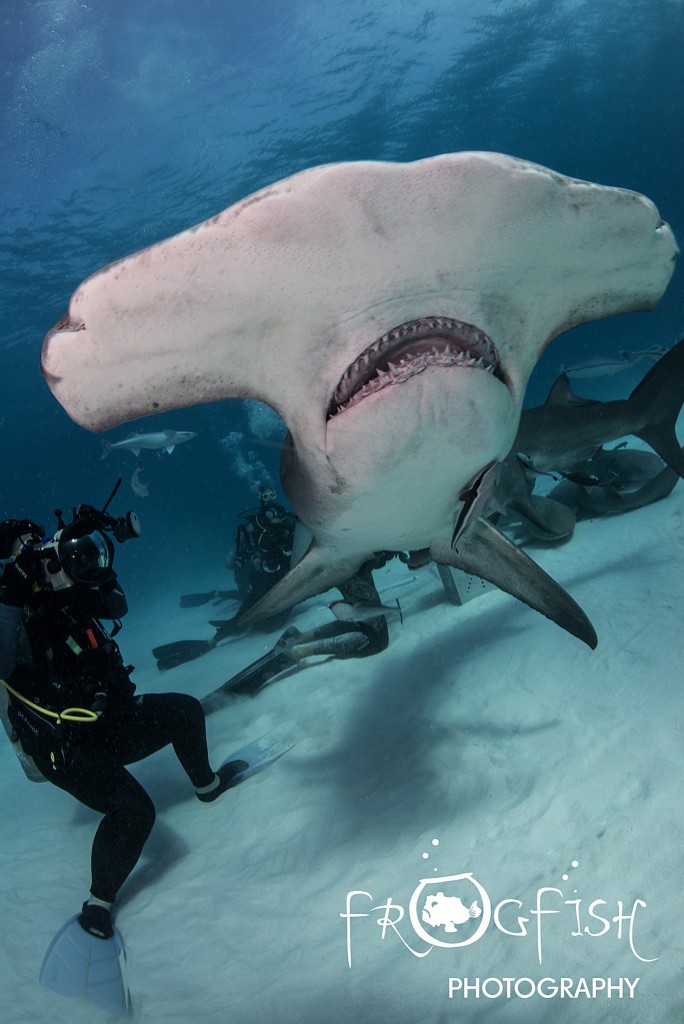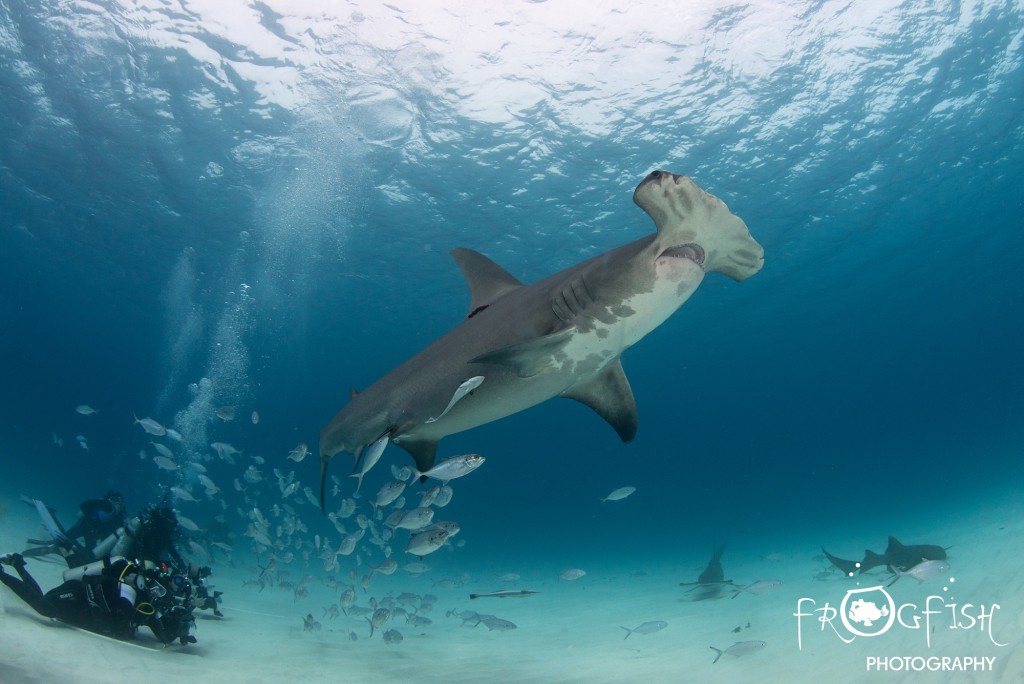News
Photographing the Hammerhead Sharks of Bimini, Bahamas (Watch Video)

 If you want to get up close and personal to photograph Great Hammerhead sharks then Bimini, in the Bahamas, is the place for you. Every winter, Great Hammerhead Sharks frequent the shallow clear waters around these tiny islands and divers flock to see them. The conditions are usually perfect for underwater photographers, as the dives are in shallow water (7-10m), giving plenty of natural light to work with. The water is warm and the visibility great, so you can stay underwater for long dives to maximise your photographic opportunities. The sharks come in very close, attracted by fish in a metal bait box, so you can use a wide angle or a fish-eye lens to get dramatic shots.
If you want to get up close and personal to photograph Great Hammerhead sharks then Bimini, in the Bahamas, is the place for you. Every winter, Great Hammerhead Sharks frequent the shallow clear waters around these tiny islands and divers flock to see them. The conditions are usually perfect for underwater photographers, as the dives are in shallow water (7-10m), giving plenty of natural light to work with. The water is warm and the visibility great, so you can stay underwater for long dives to maximise your photographic opportunities. The sharks come in very close, attracted by fish in a metal bait box, so you can use a wide angle or a fish-eye lens to get dramatic shots.
We always dive with Neal Watson when we head to Bimini. Throughout the season, which runs from December to April, you can do a 2 tank dive each morning and experience something very special. Your two guides will get into the water first and get the bait set-up in the correct position depending on any current. We have never had to wait long for the first shark to turn up and you can see them swimming over the sandy sea bed from the boat as you gear up. The Great Hammerhead Shark can grow to over 5m in length and are impressive at the best of times, but when you have one swim right over your head, it is something to behold.
 As you kneel on the seabed the sharks will follow the scent up current and make their way to your location. There are usually around 8 divers in the water, positioned in a line with the bait and guide in the middle. The sharks swim slowly past on their way to and from the bait box and seem to take it in turns, making this dive a photographic treat. It is not at all chaotic, like some shark-baiting dives, giving you time to compose your shots (once you have got over the initial excitement). Our record is 8 individual Great Hammerhead Sharks on a single dive.
As you kneel on the seabed the sharks will follow the scent up current and make their way to your location. There are usually around 8 divers in the water, positioned in a line with the bait and guide in the middle. The sharks swim slowly past on their way to and from the bait box and seem to take it in turns, making this dive a photographic treat. It is not at all chaotic, like some shark-baiting dives, giving you time to compose your shots (once you have got over the initial excitement). Our record is 8 individual Great Hammerhead Sharks on a single dive.
While you are visiting Bimini, make sure you visit the Bimini Shark Lab, where you can get a tour to see the amazing work they do here to gain a better understanding of sharks and the ways we can help conserve them and their environment. Watch the bull sharks cruise around the harbour at Bimini Big Game Club. Head out to swim with Atlantic Spotted Dolphins. For such a tiny island, there is plenty to keep an ocean lover and photographer entertained!
This is a perfect stop on a multi-island tour of the Bahamas. If you want to photograph sharks, then these islands have a huge amount to offer. Watch out for next articles about photographing Caribbean Reef Sharks in Nassau and Lemon Sharks in Grand Bahama.
Tips for Great Hammerhead Shark photography
- Try to position yourself so that you are not shooting directly into the bright sun.
- Try to avoid the sand stirred-up by both divers and nurse sharks in your shots.
- The most striking thing about a hammerhead, obviously, is the shape of its head and the position of their eyes, so try to get shots from different angles to show this feature off. From above looking down on the sand; at eye level up close, or as it swims over you.
- By conserving your air consumption, you can stay longer and have the dive to yourself and your buddy, later on!
- Remember to enjoy it! Put your camera aside every now and then so that you can take it the beauty of these incredible apex predators.
Video Clips
Further Information
For more from Nick and Caroline, visit www.frogfishphotography.com.
Gear News
Introducing the TR-80, IR-50 and CS-30 Regulators from DYNAMICNORD

Whether you are a beginner or a professional diver – with the three new main regulators from DYNAMICNORD, everyone will find their favourite regulator. They all look super stylish.
Excellent performance with the TR-80
Quality and performance are the be-all and end-all for regulators. It is not for nothing that the TR stands for Tec Reg. The innovative design of the TR-80 guarantees absolute reliability – even in ice-cold waters.

Perfect breathing effort at 0.8 J/l / certified for diving in waters below 10 degrees / structural design made of solid brass for best cold protection / membrane-compensated design with dry seal of the first stage / reduced exhalation effort thanks to optimized exhalation membrane and bubble deflector / adjustable Venturi (dive/predive) and adjustment knob for individual inhalation comfort / innovative design of the front cover prevents free-flow in strong currents or when diving with scooters / design made of sandblasted brass, matt chrome finish / 2 HP and 4 LP outlets / mouthpiece made of high-quality, anti-allergic silicone for maximum comfort.


Amazing underwater adventures with the IR-50
The IR-50 is the top regulator for advanced and experienced divers. Natural breathing is the essence of this regulator.

Ideal breathing effort at 0.8 J/l /certified for diving in waters below 10 degrees / compensated membrane / adjustable venturi (dive/predive) and adjustment knob for individual inhalation comfort/ outlet valve and deflector for minimum exhalation effort and reduction of bubbles on the face / design made of sandblasted brass, matt chrome finish / 2 HP and 4 NP outlets / mouthpiece made of high-quality, anti-allergic silicone for maximum comfort.


The Workhorse – our CS-30
For diving centres and diving beginners – the workhorse stands for strong construction, reliability and robustness. Perfect for your training.

Optimal breathing effort at 0.8 J/l /recommended for diving in waters above 10 degrees / non-compensated piston / adjustable venturi (dive/predive) / outlet valve and deflector for minimum exhalation effort and reduction of bubbles on the face / design made of sandblasted brass, matt chrome finish / 1 HP and 3 NP outlets / mouthpiece made of high-quality, anti-allergic silicone for maximum comfort.


Octopus OP-30
The OP-30 is the ideal addition to all DYNAMICNORD regulators. It is identical in construction to the CS-30.

The TR-80, IR-50, CS-30 (DIN & INT) regulators and the Octopus OP-30 are available from DYNAMICNORD dealers and in the online store.
DYNAMICNORD – Your Outdoor Companion.
Marine Life & Conservation
Paul Watson Released as Denmark Blocks Japan’s Extradition Bid

Renowned anti-whaling activist Paul Watson has been released from custody in Greenland after spending five months in detention. Denmark’s Justice Ministry rejected Japan’s request for his extradition, citing insufficient guarantees that his time already served in custody would be credited against any potential sentence.
The 74-year-old Canadian-American was arrested on July 21 in Nuuk, Greenland’s capital, when his ship docked to refuel. His arrest was based on a 2012 Japanese warrant related to a 2010 encounter in Antarctic waters. Japan alleged Watson obstructed operations and caused damage to a whaling research ship during efforts to disrupt illegal whaling. Watson has consistently denied these claims, maintaining his commitment to marine conservation.
Denmark, which oversees extradition matters for Greenland, concluded that while the legal conditions for extradition were met, the lack of assurances from Japan regarding time-served credit made extradition untenable.
In a video shared by his foundation, Watson expressed gratitude and relief, saying, “After five months, it’s good to be out… and good to know they’re not sending me to Japan.” He added that the most difficult part of his time in custody was being separated from his two young sons.
Watson is a pioneering figure in marine conservation, known for founding the Captain Paul Watson Foundation in 2022 after decades of activism with the Sea Shepherd Conservation Society. His bold efforts to defend marine life have earned him widespread support, including from celebrities and conservationists. His work has also been featured in the acclaimed reality TV series Whale Wars.
Watson’s lawyer, Jonas Christoffersen, praised the decision, stating, “We are happy and relieved that Paul Watson is now free.” He added that Watson is eager to reunite with his family and continue his vital work.
The arrest occurred while Watson’s vessel, the M/Y John Paul DeJoria, was en route to the North Pacific with a team of 26 volunteers to intercept a Japanese whaling ship. His foundation described the arrest as politically motivated and emphasized that Watson’s actions were focused on ending illegal whaling practices.
Japan resumed commercial whaling in 2019 after leaving the International Whaling Commission, asserting that whale meat is a cultural tradition. Conservationists, however, continue to challenge these practices, highlighting their impact on marine ecosystems.
Despite the challenges, Watson remains steadfast in his mission to protect marine life and bring attention to whaling practices. His dedication to ocean conservation has made him a globally respected advocate for the environment.
-

 News2 months ago
News2 months agoIconic SS United States to become the World’s Largest Artificial Reef
-

 News3 months ago
News3 months agoBook Review – 52 Assignments: Underwater Photography
-

 Gear News3 months ago
Gear News3 months agoDYNAMICNORD – New German diving brand enters the British market
-

 News3 months ago
News3 months agoExploring Cenote El Pit: A Diver’s Dream
-

 Gear News3 months ago
Gear News3 months agoTry BARE drysuits (and maybe even win one!) this Friday with Sea & Sea at North West Dive Fest
-

 Marine Life & Conservation3 months ago
Marine Life & Conservation3 months agoBook Review: Coral Triangle Cameos
-

 Blogs2 months ago
Blogs2 months agoDive the Egyptian Red Sea this Autumn with Regaldive
-

 News3 months ago
News3 months ago2024 Ocean Art Underwater Photo Competition Announced


















